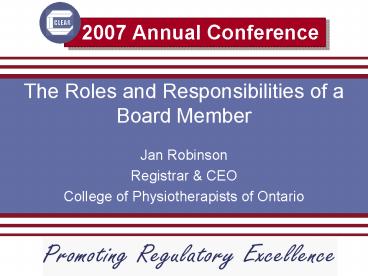The Roles and Responsibilities of a Board Member - PowerPoint PPT Presentation
1 / 40
Title:
The Roles and Responsibilities of a Board Member
Description:
In our time together. key elements of good governance. responsibilities ... 'in camera' Council on Licensure, Enforcement and Regulation. Atlanta, Georgia ... – PowerPoint PPT presentation
Number of Views:62
Avg rating:3.0/5.0
Title: The Roles and Responsibilities of a Board Member
1
The Roles and Responsibilities of a Board Member
2007 Annual Conference
- Jan Robinson
- Registrar CEO
- College of Physiotherapists of Ontario
2
- In our time together
- key elements of good governance
- responsibilities
- high performing organization
- public information
3
- setting the stage
4
- public organization
5
- protect public Interest
6
- governance is governance is governance
7
- adding value
- strategic direction
- organization well being
- financial health
- quality (perception)
- high performing CEO
8
- key behavior
- -- ask probing questions
9
- responsibilities or duties
- duty of care
- duty of loyalty
- duty of obedience
10
- duty of care unity of accountability
- mandate
- finance
11
- duty of loyalty unity of direction
- conflicts of interest
- one voice
- vision
12
- duty of obedience unity of command
- bylaws
- rules of order
- code of conduct
13
- Who is a Board Member responsible to ?
14
public
15
Licensee (potential)
16
Board and staff
17
- code of conduct
- What is it?
- Why have it?
18
- be knowledgeable
- respect confidentiality
- declare conflict of interest
- ask questions (respectfully)
- listen
- be objective
19
- attend
- speak with one voice
- stay out of operations
- accept nothing less
20
- High performing organization has
- one Board
- one CEO
- one vision
- one voice
21
- one staff person
22
- conflict of interest
- examples ?
23
- know the policy
24
- Achilles heel decision in bad faith
25
- public information
- laws
- decisions taken under statute
- governance (by choice)
- in camera
26
- pressure toward public disclosure
27
- benefits of an informed public
28
- benefits of an informed profession
29
- building and maintaining
- strong relationships
30
- communication tools
- ? audience dependent
31
- evaluate Board performance
32
- Summary
- responsible to many
- governance not operations
- partners in leadership
- build public trust
33
Scenario 1
- Jenny is a nurse and pleased that her
colleagues have elected her to sit on her local
nursing board. She is enthusiastic about her
profession and wants to contribute. She reads
all of her Board materials before a meeting and
contributes fully to the debate and decision
making. The last meeting, however, was very
challenging.
34
- A particularly difficult matter was raised for
decision. Jenny had reviewed the background
material before the meeting and felt this matter
was particularly important to profession. Jenny
believed the proposed recommendation should not
be supported. Jenny called three of her board
colleagues before the meeting to discuss her
position.
35
- During the meeting, Jenny spoke vigorously
against the motion but in the end the
recommendation was passed. Jenny cannot believe
the Board couldnt see the problems with their
decision, and is concerned her reputation is at
stake with her nursing colleagues.
36
- She has decided to send out a flyer to help
them understand the challenges with this issue,
her opinions, and the debate at the Board. She
is planning to encourage nurses to write to the
Board and suggest they overturn their previous
decision.
37
Scenario 2
- Paul is an experienced board member. He has
set on several not for profit boards and is
pleased to have been elected to the health board
as a public member. He is an accountant and has
much experience to offer. At his first meeting,
he listens to the finance report with interest.
He asks many questions relevant to the numbers
38
- presented. He is surprised that few of his
fellow board members have any comments. Paul
wonders if they really know how to read financial
statements. - After the meeting, Paul speaks to the Chair
and expresses his concern. The Chair recognizes
Paul is eager and assures him that the Board is
well
39
- informed and knowledgeable. They trust the
CEO on this matter. Paul is unhappy with this
response and calls the CEO the next day. He asks
for new, easier formatting of the reports for the
next meeting and an education session for board
members on how to read financial statements.
40
Speaker Contact Information
- Jan Robinson
- Registrar CEO
- College of Physiotherapists of Ontario
- e-mail jrobinson _at_collegept.org
- www.collegept.org































